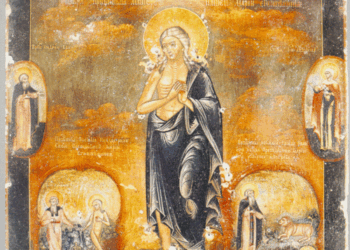The architectural competition launched in the spring of last year for the redevelopment of the British Museum’s Western Range has come to an end. The Paris-based Lebanese architect Lina Ghotmeh has emerged triumphant from a rigorous process that sifted through more than sixty international entries before challenging the five finalists to a series of workshops and “design exercises.”
The British Museum has seen many architectural changes over its 272-year history. Most recently, Norman Foster’s crystalline encasement of the Great Court, completed in time for the millennium, endowed the museum with the largest covered square in Europe. Ghotmeh’s intervention will be more radical still. The Western Range makes up one third of the museum’s footprint and is home to the collections from ancient Egypt, Greece, and Rome. Here lie the greatest treasures: the Rosetta Stone, the Parthenon Marbles, and the Assyrian Lion Hunt.
For any architect, such a task would be career-defining, but for Ghotmeh it will be especially so. She has taught at Yale and Harvard, and her Hermès workshops in Normandy and the Serpentine Pavilion in London have won loud acclaim. But of the five finalists in the design competition, her studio is one of the least established. Zurich’s Kunsthaus, New York’s New Museum, and London’s National Portrait Gallery all featured in the portfolios of her competitors, but the fresh lucidity of Ghotmeh’s ideas set her plans apart.
Too often, architects are released from design schools and run in one of two directions: either towards “style,” drawn by the promise of features in lifestyle magazines alongside clothes and celebrities, or towards “intellect,” with spectacled judges awarding little-understood prizes to acronymically titled studios for works of illustrated philosophy. Ghotmeh is one of the few who stand firm in the middle, unafraid to use drama and flair to articulate an architectural narrative.
Ghotmeh’s theme, “Archaeology of the Future,” hints at a new way of understanding museums themselves: as layered landscapes “where historic narratives intertwine with contemporary perspectives.” Her initial visualizations celebrate this idea. In a newly created central hall, monumental walls of rough, megalithic limestone speak of the grandeur of antiquity and contrast with the fragility of the exhibitions.
Of the museum’s eight million objects, only around 1 percent are on display. To create Ghotmeh’s hall, the current ground floor will be peeled back, and an incision will be cut through into the museum’s nineteenth-century vaults below. The space, lit by a clerestory, is covered by a drooping ceiling, reminiscent of an archaeologist’s tarp, pulled over a trench mid-dig. The concept chimes with the archaeological theme and cleverly articulates the museum’s wish to bring more of the collection to light.
In recent years, the British Museum has battled with a number of unflattering news stories. In addition to the age-old debates around repatriation and sponsorship from the oil company BP, the museum last year had to contend with the more novel embarrassment of a rogue curator’s allegedly selling parts of its collection—on eBay. The appeal of Ghotmeh’s promise, therefore, to “transform the Western Range into a . . . place of dialogue and reinvention” is evident. Then again, as Britain’s busiest tourist attraction with nearly six million visitors each year, it is perhaps a moot point how vulnerable the museum’s popularity is to such press—and open to question to what extent increasing visitor numbers is desirable.
The exhibition of the five finalists’ visions was held in the museum’s orb-like Reading Room, which sits at the very center of the site. This splendid structure, the architectural personification of Mycroft Holmes, served as the de facto home of the British Library until the 1990s, when its tens of thousands of books were decanted into the library’s purpose-built facility at St Pancras. Since then, the Reading Room has tried out a number of roles: exhibition space, information center, and archive. Now, its half-empty shelves serve as overflow accommodation for the museum’s reference books. It is an undignified look. The sporadic groups of ugly modern tomes seem at home in the Reading Room as much as flip-flops do in a gentleman’s club. Rows of leather-bound desks replete with quill-holders, once hunched over by Karl Marx and Sir Arthur Conan Doyle, lie scuffed and empty upon dank grey carpet, far off behind a rope. It is a space so eminently ripe for reading it cannot be long before the museum realizes as much and restores its function. Until then, with no clear role or future decided for such a treasure as this, the rationale for commissioning another architectural flourish is questionable.
The core of the museum, along with its famous southern façade, was completed in the 1850s to the designs of Robert Smirke. Designing a museum in nineteenth-century Europe was like fitting a suit for a pufferfish. Smirke was forced to make several revisions to account for the growing collections—the arrival of various Lycian sculptures in 1842 and the Nereid Monument in 1848 demanded considerable extensions—and the museum’s expansion continued long after Smirke’s death. The Western Range now comprises a jumble of ten additional buildings, including the New York architect John Russell Pope’s terrifyingly sober Duveen Gallery, London’s answer to the Reich Chancellery.
In recent decades, technological advances in the study of crowd behavior and traffic modeling have greatly improved gallery design and layout, as in the collaboration between Space Syntax and the Tate Gallery. It remains to be seen how Ghotmeh will approach the issue of navigation in the muddle of the Western Range: creating intuitive pathways that maximize pedestrian efficiency? Or perhaps playing to the archaeological theme by leaving some exhibitions to be “discovered” by only the most searching visitor?
Smirke was part of a tradition that relied on exciting an emotional response as the foundation for establishing interest in the mind of the visitor. Who, standing before the grandeur of Smirke’s southern entrance, could resist the spell and walk on by? If Ghotmeh follows in this tradition of architectural bravura, she will find a more powerful tool than intuition to guide visitors and will be doing a service not only to the British Museum but also to contemporary architecture.

















